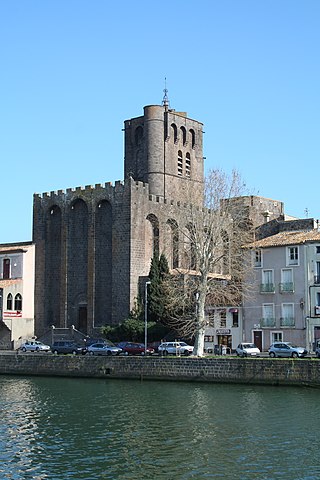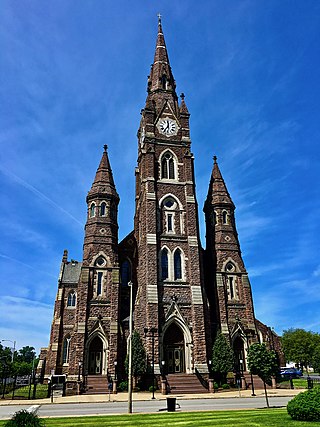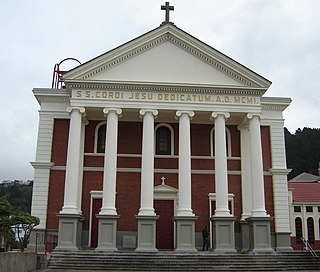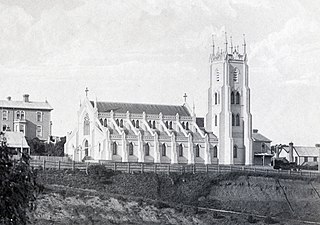
Chartres Cathedral, also known as the Cathedral of Our Lady of Chartres, is a Catholic church in Chartres, France, about 80 km southwest of Paris, and is the seat of the Bishop of Chartres. Mostly constructed between 1194 and 1220, it stands on the site of at least five cathedrals that have occupied the site since the Diocese of Chartres was formed as an episcopal see in the 4th century. It is one of the best-known and most influential examples of High Gothic and Classic Gothic architecture, It stands on Romanesque basements, while its north spire is more recent (1507–1513) and is built in the more ornate Flamboyant style.

The Cathedral Basilica of the Sacred Heart, the fifth-largest cathedral in North America, is the seat of the Roman Catholic Archdiocese of Newark. Headed by Cardinal Tobin for the archdiocese, it is located in the Lower Broadway neighborhood of Newark, New Jersey. Catholic mass is offered daily and three times on Sunday in English and in Spanish.

The Cathedral Basilica of Our Lady of Peace is the mother church and cathedral of the Diocese of Honolulu.

Agde Cathedral is a Roman Catholic church located in Agde in the Hérault département of southern France. The cathedral is dedicated to Saint Stephen, and stands on the bank of the river Hérault.

St. Michael's Cathedral Basilica is the cathedral church of the Roman Catholic Archdiocese of Toronto, Canada, and one of the oldest churches in Toronto. It is located at 65 Bond Street in Toronto's Garden District. St. Michael's was designed by William Thomas, designer of eight other churches in the city, and was primarily financed by Irish immigrants who resided in the area. The cathedral has a capacity of 1600. John Cochrane and Brothers undertook the work on the stone and stucco ornamentation of the interior.

The Church of Saints Peter and Paul is a Roman Catholic church in Singapore. It is located at Queen Street within the Central Area known as the Bras Basah Bugis precinct of Singapore's arts district.

Sacred Heart Cathedral, Bendigo, is the Roman Catholic cathedral church of the Diocese of Sandhurst and seat of Bishop Shane Mackinlay. The cathedral is located in the provincial city of Bendigo, Victoria, Australia.

The Cathedral of St. John the Baptist is the mother church of the Roman Catholic Diocese of Charleston, located in Charleston, South Carolina. Designed by Brooklyn architect Patrick Keely in the Gothic Revival style, it opened in 1907. The Most Reverend Jacques E. Fabre, the fourteenth Bishop of Charleston, was ordained and installed on May 13, 2022

The Co-Cathedral of the Sacred Heart is a place of worship located at 1111 St. Joseph Parkway in downtown Houston. The co-cathedral seats 1,820 people in its 32,000-square-foot (3,000 m2) sanctuary. Together with the venerable St. Mary's Cathedral Basilica in Galveston, Sacred Heart serves more than 1.2 million Roman Catholics in the Archdiocese of Galveston-Houston.

The Basilica of Saint Clotilde is a basilica church located on the Rue Las Cases, in the 7th arrondissement of Paris. It was constructed between 1846 and 1856, and is the first example of a church in Paris in the neo-Gothic style.

The Diocese of Wagga Wagga is a Latin Church suffragan diocese of the Archdiocese of Sydney, established in 1917, covering the Riverina region of New South Wales in Australia.

St. Peter Cathedral is a Roman Catholic church located at 230 West 10th Street in Erie, Pennsylvania.

The Metropolitan Cathedral of the Sacred Heart and of Saint Mary His Mother, better known as Sacred Heart Cathedral, is a Roman Catholic cathedral church on Hill Street, Wellington, New Zealand. It is the parish church of the Thorndon Catholic parish and the seat of the Archbishop of Wellington. The New Zealand Parliament is a close neighbour of the cathedral. However, the Thorndon Catholic parish predates that institution. The cathedral is part of a Catholic precinct which includes: St Mary's College; Sacred Heart Cathedral School; St Mary's Convent, the motherhouse of the Sisters of Mercy in Wellington; the Catholic Centre, in which Catholic administration is located; and Viard House, which is both the cathedral parish presbytery and the residence of the archbishop.

The Roman Catholic Archdiocese of Guangzhou (Canton) is an archdiocese located in the city of Guangzhou in China.

Sacred Heart Cathedral in Sibu, Sarawak is the mother church of the Roman Catholic Diocese of Sibu. It is the seat of the Bishop of Sibu, currently Joseph Hii Teck Kwong.

The Cathedral of the Good Shepherd located in the city of San Sebastián, Gipuzkoa, Basque Country, Spain. It is the seat of the suffragan Diocese of San Sebastián and subordinated to the Archdiocese of Pamplona y Tudela. The most remarkable religious building of San Sebastián, it is endowed with a strong verticality and is the largest in Gipuzkoa. Its construction took place in the last years of the 19th century in a Historicist Neo-Gothic style. The church, dedicated to the Good Shepherd, has held the rank of cathedral since 1953.

St Mary's Cathedral was a former Roman Catholic cathedral church located in Wellington, New Zealand. Completed in 1851, the cathedral served as the mother church for the Archdiocese of Wellington and the seat of the Catholic Bishop of Wellington until the building was destroyed by fire in 1898.

The Sacred Heart Basilica or Timaru Basilica, is a Catholic church in Timaru, New Zealand. Despite its name, it is not legally designated as a basilica by the Catholic Church. It was designed by the New Zealand architect, Francis Petre and is one of his most celebrated works. Its size and appearance make it one of the most important historic buildings of Timaru and of the South Canterbury region. The Basilica's twin towers and copper cupola are highly visible features of the Timaru skyline, especially from the south. The Basilica is also one of the "most noteworthy examples of ecclesiastical architecture" in New Zealand with elements of "Roman and Byzantine architecture with touches of Art Nouveau decoration." It is a registered historic place, category 1.

Holy Name of Jesus Cathedral is a Catholic cathedral that is the seat of the Diocese of Raleigh, replacing Sacred Heart Cathedral.
Philippe François Zéphyrin Guillemin was a Roman Catholic bishop.













































